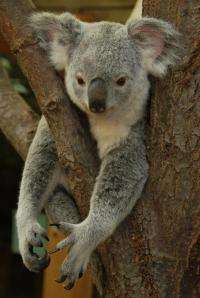Hanging in there: Koalas have low genetic diversity

A species relies on genetic diversity to survive and low diversity usually indicates that there has been inbreeding due to a decrease in population size. By looking at historic mitochondrial DNA (mtDNA) from museum samples, new research published in BioMed Central's open access journal BMC Genetics has found that koalas (Phascolarctos cinereus) have had low genetic diversity for over 120 years.
The genetic diversity of koalas is known to be low in modern populations but historical reports suggest that koala populations have had a chequered past. When Europeans first noticed koalas in the late18th century they noted that numbers of this newly described species (originally called Lipurus cinereus) were very low due to Aboriginal hunting and they believed that the species would soon become extinct. Instead hunting declined allowing the koala to become a common animal by the mid 1800s.
At this point in time koala fur became fashionable and the international fur trade decimated the population once more. The koala population was also hit by loss of their habitat to European settlement, and by devastating epidemic diseases such as Chlamydia.
Researchers from Germany, Denmark and the USA compared the mitochondrial DNA of modern koalas and 14 museum specimens from across the world (where the date of the specimen was known) to see how these changes in population sizes had affected koala genetic diversity. Despite the 14 historic koalas being from different places and time points, they each had only one of four different haplotypes (variations in the mtDNA hypervariable region) and all of these can be found in modern koalas.
Prof Alex Greenwood, from the Leibniz-Institute for Zoo and Wildlife Research, who led this study, commented, "We thought that, like other species such as the grey wolf where the population has recently declined, there should be greater diversity in museum samples than modern specimens. We found this not to be true. The event which reduced the genetic diversity of koalas must have happened a long time ago, perhaps during the late Pleistocene when the larger species of koala, P. stirtoni, became extinct."
Low genetic diversity may mean that the species is less able to survive changes to its environment such as global warming, or competing for habitat with humans. The low diversity may also be responsible for the widespread inability of the koala to resist diseases such as Chlamydia and the newly discovered koala retrovirus (KoRV).
Journal information: BMC Genetics
Provided by BioMed Central




















